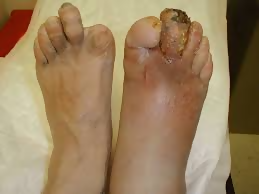
Diabetes is a disease that results in inadequate and faulty production or less sensitivity to insulin. Insulin is an important hormone in the body whose function is to assist the cells in absorbing sugar from the blood so that it can be utilized for producing energy. When this whole process gets disturbed or does not work properly, then the sugar keeps circulating in the blood which leads to various health issues.
If high levels of sugar continue to persist for a longer period of time, it can harm many parts of the body including the feet. According to a recent survey, diabetes is accountable for causing over 50 percent of foot amputations in the United States. People suffering from diabetes are more susceptible to developing foot problems that result due to high levels of blood sugar. Some of the most common foot problems that occur due to diabetes are peripheral vascular disease and diabetic neuropathy. Both these problems are known to result in severe complications
The foot problems that are triggered due to diabetes
The two major foot problems that are caused as a result of diabetes are:
- Peripheral Vascular Disease-
Diabetes results in alterations in the blood vessels especially the arteries. In this disease, the fatty deposits cause an obstruction in the blood vessels beyond the heart and brain. Peripheral Vascular disease has the tendency to affect the blood vessels leading back and forth from the ends like the hands and feet, minimizing the flow of the blood to both the parts. The decreased level of blood flow can result in wounds that recover at a slow pace, pain, and infection. This disease can develop a serious infection and in such a case, a footdoctor in Houston at DeNiel Foot & Ankle Center may recommend foot amputation. A person suffering from peripheral vascular disease is also prone to develop ulcers and gangrene (a condition that is caused due to the death of the tissue because of the lack of blood.)
Over a period of time, diabetes can result in nerve damage that causes numbness in the foot. Such a condition makes it more difficult for a person to feel sensation in the hands and feet. Diabetic neuropathy also makes it challenging for a diabetic patient to feel any infection, irritation, or soreness at the extremities. They may also not be able to observe when their shoes are rubbing. Diabetic neuropathy can result in a greater risk of blisters, cuts, and sores.
If a person suffering from diabetes does not undergo treatment for the condition, then it can lead to the development of ulcers, infections, and even gangrene.
Symptoms of foot problems
According to DeNiel Foot & Ankle Center’s podiatrists in Houston, foot symptoms that result due to diabetes are as follows:
1) Wounds with drainage
2) Stained socks
3) Severe tingling
4) Blisters without any pain
5) Red striations
6) Numbness or lack of sensation
7) Temperature variations and skin discoloration
In case of an infection, a diabetic patient may also experience:
1) Chills
2) Shaking
3) Fever
4) High blood sugar levels
5) Redness
Treatment for foot problems
Different surgical and non-surgical options are available for the treatment of foot problems:
A Houston podiatrist will initially try to treat the condition without any surgery by cleaning and dressing the wound, wearing a total contact cast or cast boot, or carefully observing any gangrene till self-amputation occurs.
It includes the removal of dead tissues, amputations, surgical stabilization, arterial bypass, and endovascular surgery.
It is important that you take care of foot hygiene. You can do this by taking steps like washing the feet daily, wearing supportive shoes, trimming nails cautiously, controlling blood sugar levels, going for regular foot examinations, and caring for bunions as well as corns.
If you have any questions, please feel free to contact our office located in Houston,TX. We offer the newest diagnostic and treatment technologies for all your foot and ankle needs.